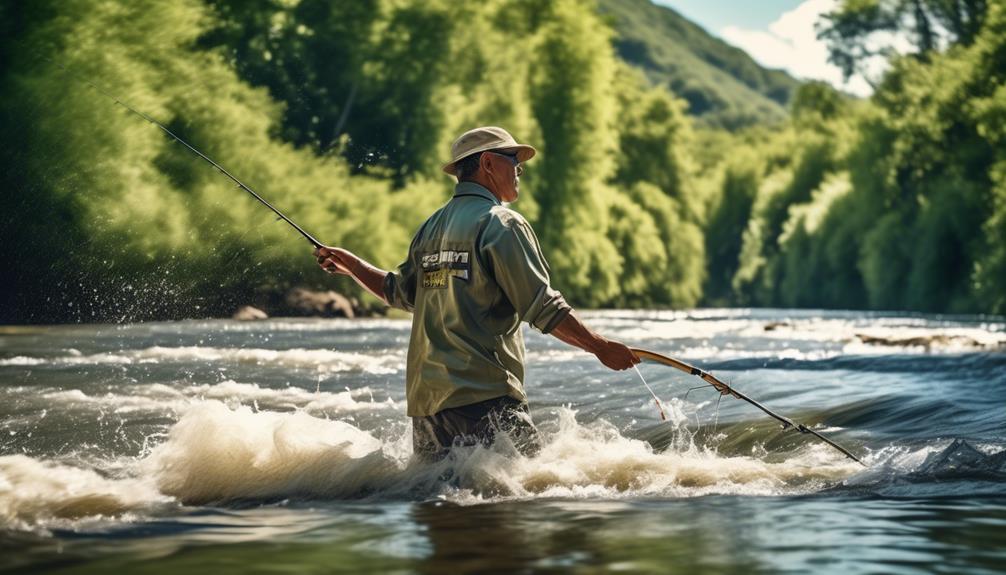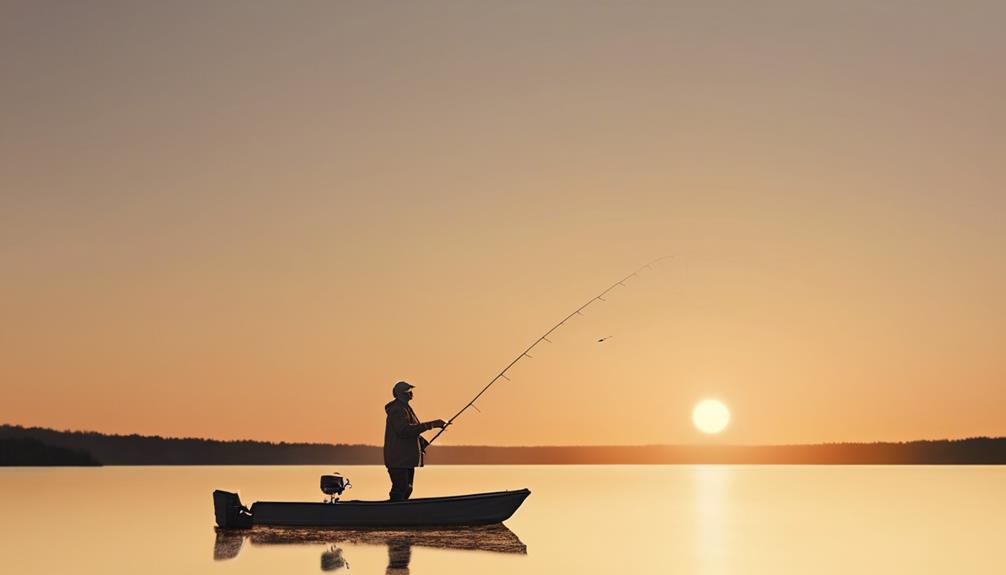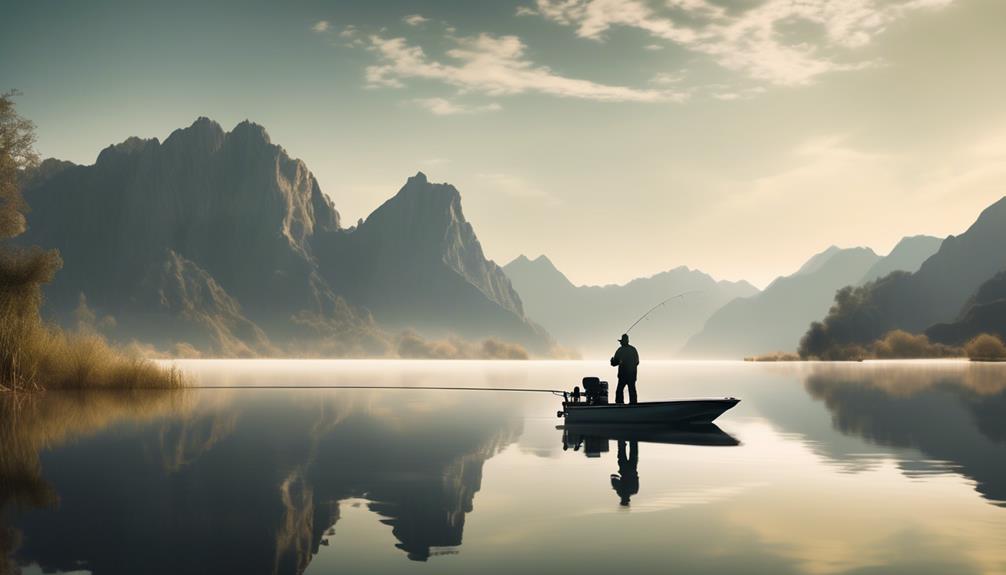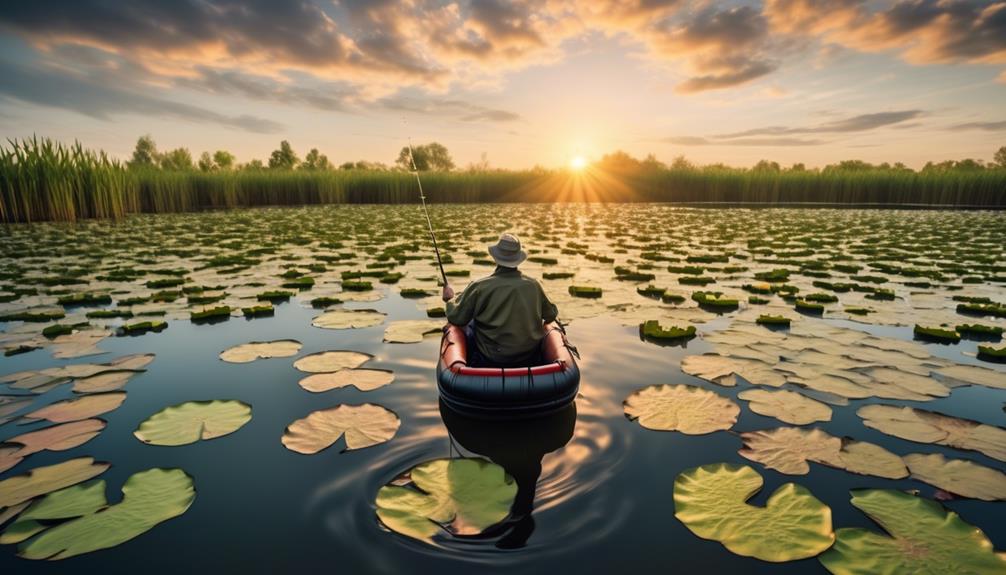You might think that bass fishing in rivers is just like fishing in lakes, but the truth is that river bass fishing requires a different set of techniques to be successful. Whether you're new to river bass fishing or looking to up your game, understanding these expert techniques can make all the difference in your catch rate.
From topwater lure strategies to deep diving crankbait tactics, there are numerous methods to master. So, let's dive into the world of river bass fishing and discover the 12 expert techniques that can take your angling to the next level.
Topwater Lure Techniques
To increase your chances of catching bass in rivers, consider using topwater lures during the early morning or late evening for optimal results. Surface popper tactics can be highly effective when targeting bass in river environments. The key is to use a popping or chugging action to create a commotion on the water's surface, mimicking the sound of baitfish or insects. This can trigger aggressive strikes from bass, especially during low light conditions.
Topwater frog secrets involve using lifelike frog lures that can be worked over lily pads, grass, and other vegetation where bass are known to hide. The realistic appearance and action of these lures can entice bass to strike, making them a valuable addition to your river fishing arsenal.
Walking bait tricks can also prove fruitful when targeting river bass. These lures are designed to imitate injured baitfish, and by twitching the rod tip during retrieval, you can make the lure dart from side to side, creating an enticing action that can tempt bass into striking.
Additionally, propeller lure techniques involve using lures with spinning blades that create a unique disturbance on the water's surface. The flash and vibration produced by these lures can be irresistible to bass, especially in river settings where they're actively hunting for prey.
Deep Diving Crankbait Strategies
Using deep diving crankbaits can be highly effective for targeting bass in rivers, allowing you to reach greater depths where bass are known to lurk. When using deep diving crankbaits in rivers, it's important to understand bottom bouncing and deep water techniques to maximize your success.
Bottom bouncing refers to the technique of allowing the crankbait to make contact with the riverbed, creating a deflection action that can trigger strikes from bass holding near the bottom. To achieve this, cast your deep diving crankbait upstream and reel it in, allowing it to bump into rocks, logs, or any structure on the river bottom. This mimics the behavior of natural prey, making it an irresistible target for bass.
Incorporating deep water techniques involves focusing on areas of the river where the water is significantly deeper. Look for drop-offs, ledges, and other underwater structures where bass may be congregating. Deep diving crankbaits are designed to reach these depths, so casting along these underwater structures and varying your retrieval speed can entice bass to strike.
When fishing in deep water, it's crucial to use a high-quality fishing line and a sensitive rod to feel the subtle bites from bass lurking in the depths. Pay attention to the behavior of the crankbait and be prepared to set the hook at the slightest indication of a strike.
Jigging and Flipping Approaches
Exploring alternative techniques after mastering deep diving crankbait strategies, you can now shift your focus to the effective methods of jigging and flipping for river bass fishing. These techniques are particularly useful when targeting bass in shallow waters and heavy cover.
When jigging and flipping, it's essential to use the right gear and adopt specific approaches to maximize your chances of landing a big catch.
Here are some key points to consider:
- Weedless Presentation, Shallow Water: Utilizing weedless jigs or Texas-rigged soft plastic baits can help prevent snagging in weedy or shallow areas. This presentation allows you to navigate through vegetation and target bass in their natural habitat without getting entangled.
- Precision Casting, Heavy Cover: When flipping, accuracy is crucial. By using heavy-duty rods and reels, you can make precise casts into dense cover where bass often seek refuge. This method requires a controlled approach to drop your bait directly into the strike zone, enticing bites from elusive bass hiding in thick vegetation or under debris.
Current and Drift Fishing Methods
Understanding river current and bass behavior is crucial for successful fishing. Bass are opportunistic feeders and often position themselves strategically to conserve energy while waiting for prey to be carried by the current. When the river current is strong, bass tend to seek calmer waters where they can conserve energy, such as behind rocks, logs, or any other structure that breaks the current. By identifying these areas, you can effectively target bass using drift fishing techniques.
Drift fishing involves allowing your bait to be carried naturally by the current, presenting it in a lifelike manner to the bass. To achieve this, use bait that mimics the natural forage present in the river, such as crayfish, minnows, or other small river creatures. When presenting your bait, consider the direction of the current and position yourself upstream from the targeted area. This allows the bait to drift naturally towards the bass, increasing the chances of a successful strike.
Furthermore, understanding how river current affects bait presentation is essential. In areas with faster current, bass rely on their lateral lines to detect vibrations and movements, making noisy or highly visible baits less effective. Instead, opt for subtle presentations and natural-colored baits to entice bass in these conditions.
Finesse Techniques for River Bass
When targeting bass in river environments, it's essential to finesse your techniques, especially after employing current and drift fishing methods to understand the subtleties of bass behavior. Finesse techniques for river bass can make all the difference in getting those finicky fish to bite.
Here are some effective finesse techniques to consider:
- Precision casting: In river settings, accuracy is crucial. Bass often hide in tight spots, such as behind rocks or under overhanging branches. Making precise casts to these areas increases your chances of enticing a strike. Practice casting to specific targets, honing your accuracy to reach those elusive bass hiding in cover.
- Stealthy retrieves: Once your bait is in the water, a subtle and stealthy retrieval is key. River bass can be easily spooked, especially in clear water. Slow and deliberate retrieves, with subtle twitches and pauses, can mimic natural movement and tempt cautious bass into striking. Pay close attention to the feel of your line and be prepared for a light tap or tug.
- Light line and tackle: Utilizing lighter line and tackle can enhance finesse fishing. Downsizing your line and using finesse-specific gear allows for more delicate presentations, especially in clear water conditions. This approach can result in more bites from wary river bass.
- Natural bait presentations: Emulate natural bait movements by using finesse techniques such as drop shot rigs, wacky rigs, and weightless soft plastics. These methods can entice hesitant river bass and trigger strikes when other techniques fall short.
Targeting Structure and Cover Tactics
To successfully target structure and cover while fishing for river bass, employ strategic casting and retrieval techniques to entice the bass hiding in these areas. Start by adopting a stealthy approach to avoid spooking the bass. Keep a low profile and move quietly to the target area. Use polarized sunglasses to see through the water's surface and identify potential structure and cover where bass might be lurking.
Once you've located a promising spot, it's time to make precision casting your priority. Approach the target area from the downstream side to prevent your presence from alerting the bass. Make accurate casts to specific points within the structure or cover, such as downed trees, overhanging branches, or rock formations. This precision casting increases your chances of enticing a strike from the bass hiding in these areas.
As your lure lands near the structure or cover, employ a strategic retrieval technique to mimic the movement of natural prey. For example, use a slow and steady retrieve to imitate a wounded baitfish or a crayfish moving along the riverbed. Vary your retrieval speed and add occasional pauses to make your lure appear more lifelike and tempting to the bass.
Seasonal Pattern Adaptations

Adapt your fishing techniques to the changing seasons to continue targeting structure and cover effectively while river bass fishing. As the seasons shift, the behavior and location of bass change, requiring adjustments in your approach to maintain a successful catch rate. Understanding the seasonal patterns of bass will help you adapt your strategy and stay ahead of the game.
- Winter bass: During the winter months, bass tend to move to deeper waters where the temperature is more stable. Focus on slow-moving baits such as jigs or drop shots to entice sluggish winter bass. Look for areas with minimal current and deeper holes where bass may gather to conserve energy.
- Spring transition: As the water begins to warm up, bass become more active and move towards shallower waters in preparation for spawning. Target shallow cover like fallen trees, rocks, or submerged vegetation. Use fast-moving baits like crankbaits or spinnerbaits to cover a lot of water and locate active fish.
- Summer patterns: In the heat of summer, bass seek cooler, oxygen-rich waters. Look for areas with shade, such as overhanging trees or docks, and fish early in the morning or late in the evening when the temperatures are lower. Topwater lures can be highly effective during these times.
- Fall feeding frenzy: Bass feed heavily in preparation for the upcoming winter. Focus on areas where baitfish are abundant, such as near points or drop-offs. Utilize a variety of bait types to simulate the abundance of forage available to bass during this season.
Advanced River Bass Fly Fishing Tips
Consider employing specialized fly fishing techniques to enhance your river bass angling skills and increase your chances of a successful catch. Nymphing techniques can be highly effective when fly fishing for river bass. Use weighted nymphs to get down into the feeding zones of the bass, and focus on slower, deeper areas of the river where bass are likely to be holding. To effectively nymph for river bass, it's crucial to mend the line to achieve a drag-free drift, as any unnatural movement can spook the fish. Additionally, try using smaller nymph patterns that mimic the insects and small crustaceans that bass feed on.
Another advanced fly fishing technique for river bass is streamer presentations. This technique involves casting larger, more lifelike fly patterns that imitate baitfish or other larger prey that bass actively hunt. When using streamers, it's important to vary the retrieve speed and add occasional twitches to make the fly appear more natural and enticing to the bass. Target areas with cover such as fallen trees, boulders, or undercut banks, as these are prime locations for bass to ambush prey.
Frequently Asked Questions
How Can I Modify My Fishing Techniques for Different Water Conditions, Such as High Water or Low Water Levels?
When fishing in rivers, adjust your techniques for high or low water levels. For high water, focus on deeper, slower-moving areas. In low water, target shallower spots and use smaller lures to entice bass in the reduced current.
What Are Some Effective Strategies for Catching River Bass During the Spawn and Post-Spawn Periods?
During the spawn and post-spawn periods, river bass tend to move to specific locations. Use lures that mimic their natural prey and consider the river current when selecting presentation techniques. This will increase your chances of catching bass.
How Can I Locate and Target Specific Types of Cover, Such as Submerged Logs or Undercut Banks, When Fishing for River Bass?
When fishing for river bass, you can locate specific types of cover like submerged logs or undercut banks by reading currents and using positioning tactics. Then, choose the right lure selection and presentation techniques for successful fishing.
Are There Any Specialized Techniques for Catching Larger, Trophy-Sized Bass in River Environments?
When targeting larger bass in river environments, advanced lure selection and proper bait presentation are crucial. Utilize techniques like using larger swimbaits or topwater lures to entice trophy-sized bass in these dynamic and challenging waters.
What Are Some Tips for Effectively Fishing in Heavily Vegetated Areas or Areas With Dense Brush and Overhanging Trees?
When fishing in heavily vegetated areas or dense brush with overhanging trees, it's crucial to use weedless rigs and topwater baits for lure selection. Focus on casting accuracy to target bass in these challenging spots.
Conclusion
Now that you have learned these expert river bass fishing techniques, it's time to hit the water and put them into action.
Remember to stay patient and observant, and be prepared to adapt your tactics based on the conditions and behavior of the fish.
With practice and experience, you'll become a master at catching river bass in no time.
So grab your gear, head to your favorite fishing spot, and enjoy the thrill of reeling in some big bass!



